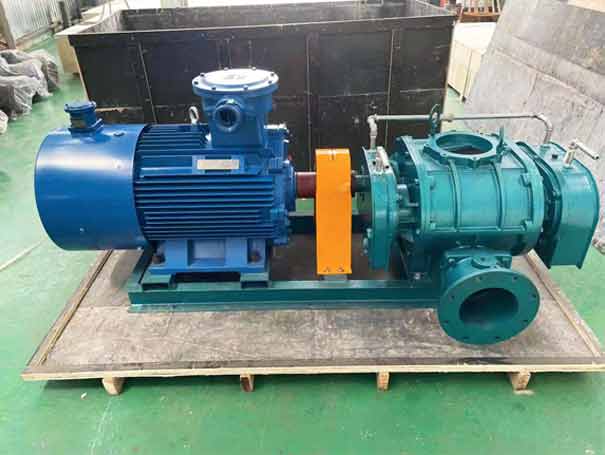 Roots blower with direct drive The speed of the main shaft is determined by the speed of the motor. If the motor speed is fixed, the speed of the main shaft is fixed. For motors of the same level, the speed is fixed and cannot be adjusted at will. Relatively speaking, the maintenance of direct drive fans requires professional technicians to operate.
Roots blower with direct drive The speed of the main shaft is determined by the speed of the motor. If the motor speed is fixed, the speed of the main shaft is fixed. For motors of the same level, the speed is fixed and cannot be adjusted at will. Relatively speaking, the maintenance of direct drive fans requires professional technicians to operate. In some industries, due to the different working environments of machinery and equipment, some roller fans need to operate in high temperature environments, such as the steel industry. In this industry, the direct drive roller fans are generally selected. The belt driven fans are prone to slip due to the poor high temperature resistance of the belt, so the belt driven fans are less used in such working environments with high temperatures, The direct drive Roots blower is widely used.
Common characteristics of direct drive Roots blower and ordinary three leaf Roots blower:
1. The direct connected Roots blower is composed of four parts: casing, wallboard, impeller, inlet and outlet muffler, etc.
2. Casing: mainly used to support wallboard, impeller, muffler and fixation.
3. Wall plate: mainly used to connect the casing and the impeller, support the rotation of the impeller, and play the role of end face sealing
4. Impeller: It is the rotating part of Roots blower, which is divided into two leaves and three leaves. Now, because the three leaves have many advantages such as less air pulsation, less noise and smooth operation than the two leaves, it has gradually replaced the two leaves Roots blower.
5. Muffler: used to reduce the noise caused by air pulsation in and out of roots blower.

model
(Directly connected to Roots blower) | Air volume range
(m?/min) | Motor power range
(kw) | Outlet diameter | Fan weight
(KG) | Pressure range | Voltage |
| Sr50 | 0.65-2.13 | 0.75-4 | DN50 | 87-119 | 9.8kp-58.8kp | 380V |
| Sr65 | 0.94-3.00 | 0.75-5.5 | DN65 | 98-145 |
| Sr80 | 2.34-5.22 | 2.2-7.5 | DN80 | 156-200 |
| Sr100 | 3.25-8.05 | 2.2-15 | DN100 | 190-297 |
| Sr125 | 5.35-11.7 | 3-18.5 | DN125 | 285-401 |
| Sr150 | 10.37-27.15 | 7.5-45 | DN150 | 471-706 |
| Sr175 | 19.65-38.67 | 11-75 | DN175 | 601-1090 |
| Sr200 | 27.65-57.14 | 15-90 | DN200 | 975-1490 |
| Sr-225 | 32.95-70.56 | 18.5-110 | DN225 | 1080-1845 |
| Sr-250s | 35.83-76.72 | 18.5-132 | DN250 | 1115-1936 |
| Sr-250/300 | 61.4-114.8 | 30-160 | DN250/300 | 1843-2761 |
| Sr-300L/300L1 | 104.1-183.6 | 37-200 | DN300 | 2031-3440 |
| Sr-350/350L | 105.5-226 | 37-280 | DN350 | 3870-5700
|

Advantages and disadvantages of direct drive three blade roots blower:
advantage:
1. The fan speed can be selected in a wide range, and the flow is closer to the application needs.
2. The fan shaft has no lateral force, and the power transmission can be very large.
Disadvantages:
1. The belt drive needs tension to add additional lateral force to the fan shaft end.
2. It is directly connected with the motor, and the optional speed is small. In most cases, the displacement of the fan is too large, so it is necessary to install a bypass pipeline to vent, which wastes a lot of power. Roots blower can be divided into belt drive Roots blower and direct drive Roots blower according to the drive mode. The direct drive Roots blower has no belt and is relatively expensive, mostly for Roots blower with fixed speed.
It is widely used in sewage treatment, aquaculture, pneumatic conveying, vacuum packaging, coal washing, combustion support, pressurization, casting, mining, metallurgy, chemical industry, light industry, building materials, power, flour, sand blasting, vacuum, etc.
Universal base, belt cover, Roots blower pulley, motor pulley, V-belt, safety valve, pressure gauge, air inlet silencer, air outlet silencer, anchor bolt, check valve, elastic joint, gear oil.


When you need to purchase Direct coupled drive three blade roots blower Please inform the following items in detail:
1. Use of Roots blower: sewage treatment, aquaculture, pneumatic conveying, etc
2. Fan specifications: caliber, required air volume, pressure rise, etc
3. Transmission medium: air, gas, biogas and other corrosive gases
4. Equipment requirements: form, cycle number, voltage, single-phase or three-phase
5. Equipment service conditions: indoor or outdoor, ambient temperature
6. Fan accessories
7. Fan color (with or without specified color
8. Note: the allowable range of specified flow and pressure rise (vacuum degree) is ± 5%

















